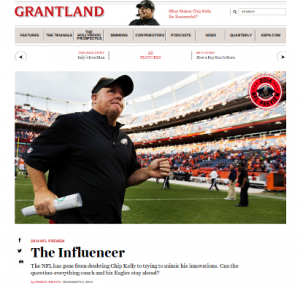Even if the Philadelphia Eagles don’t do anything this season the team’s coach, Chip Kelly, has owned the preseason. A steady stream of profiles documented his sports science approach to American football over the past few weeks (Grantland, Philadelphia Inquirer, ESPN The Magazine, CoachingSearch blog, The MMQB).
There was also a useful essay by Kenneth Corsten in Scorecard blog on sports business models, specifically the business model used by the German national soccer team that produced the recent World Cup title. Wherever there is business there are business models, and sports is no exception. So when you look at the Eagles you see that aside from player personnel decisions, the business model and coach Chip Kelly are one in the same. You can also see that sports science has little downside against considerable upside for the teams that decide to invest in it.
A longer essay on sports science business models is in the works but the basic takeaway is that these business models are difficult, mostly because they have mostly not yet been invented. So the task often becomes doing something that hasn’t ever been done before.
Fortunately it is usually enough to know that an experimental business model is effective if it is making progress towards concrete goals. If the goals for an applied sports science program are to improve athlete performance, reduce injuries, identify/develop talent, save money and win games (in whatever order), then sports science done well should do all of those things, not just some of them. Chip Kelly, by all accounts, is doing sports science well in Philadelphia.
The Best Things I Read Last Week:
- Linda Stone’s Antidote to Quantified Self: The Essential Self Xconomy … Stone, a major figure in Human-Computer Interaction research, says that all of the numbers provided by Quantified Self devices need context to address the senses that make us human, that the technology and interfaces need to get to how we feel, and not stop at changes in heart rate, weight, body chemistry, etc.
- The Guru to the Road Graders Grantland … There are valuable niches, here for offensive linemen in football, for the coach/consultant to combine training with skills development and dramatically improve individual athletes on-field effectiveness, something that teams often struggle to pull off.
- Why clubs are using Football Manager as a real-life scouting tool The Guardian, Technology … A good user interface is a good user interface. It makes sense for something that works in simulated games to also work when the games are real.
- Turning Crowdsourced Preseason NFL Strength Ratings into Game-Level Forecasts Dart-Throwing Chimp blog … Sports data analysis is crying out for effective crowdsourcing methods. I’m hoping that crowdsourcing will, in time, show that much of what currently constitutes sports analysis is crap.
- Lower-limb Muscular Strategies for Increasing Running Speed Journal of Orthopaedic & Sports Physical Therapy … A favorite theory of mine is that better runners make better athletes, and vice versa. Improve one, either running or athleticism, and you gain in the other, for free. I like papers that make my theory more plausible.
And the Most Annoying Thing I Read Last Week:
- The NFL’s Eye in the Sky Sees Everything, Often More Than Once The MMQB … MMQB is usually awful when it comes to science. The writers take turns mangling it and editors don’t know enough technically to demand anything insightful. This article looks at NFL injury technicians, people who seem to be underemployed athletic trainers paid to sit in a room with a video monitor and binoculars to make sure NFL teams pay attention when players are hurt. The article bypasses any deep discussion of science around player injuries or technology for injury detection, instead focusing on the collaboration taking place. Only the collaboration and its workflow seem unworkable in practice, something MMQB fails to grasp. Collaboration 101 will tell you that the shared work depends on a clear definition and understanding of the shared artifact a team works on, something that doesn’t seem to exist per MMQB’s description. Hard to tell which is worse, the collaboration between MMQB writers and editors, or between injury technicians and NFL teams.
